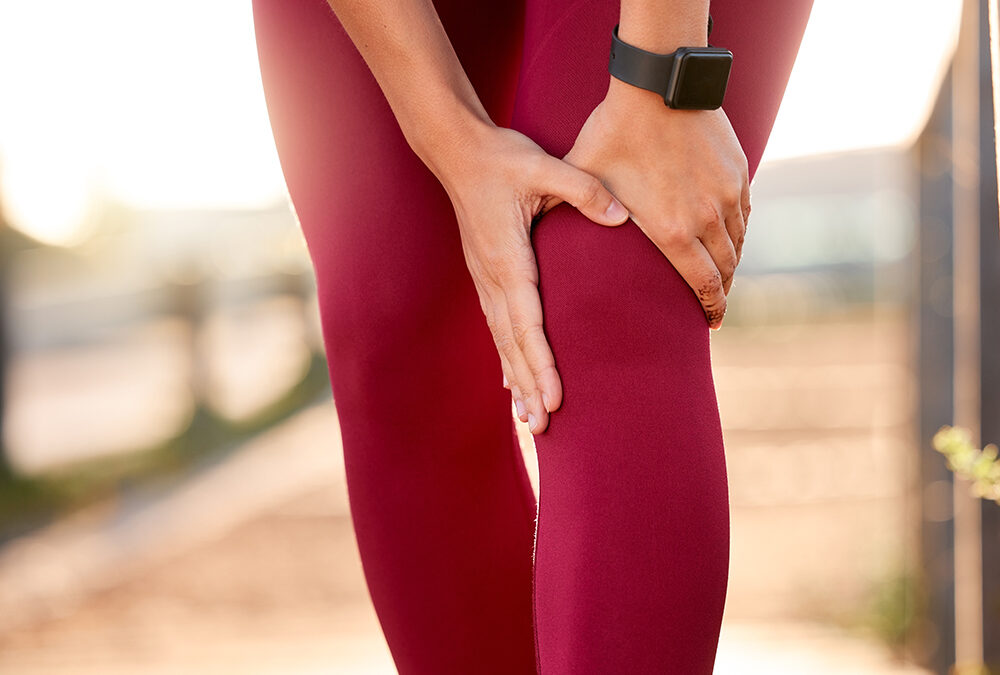Contents
Your knee is a vital part in your daily mobility. Your knees allow you to carry your body weight, stand, sit and walk. Movements you do every day, which you probably pay little to no mind to unless you are dealing with knee pain.
Common causes of knee pain
The knee joint is made up of the femur (thighbone), tibia (shinbone), patella (kneecap), muscles, tendons and ligaments. Pain in the knee is experienced by approximately 25% of adults. When your knee is causing you pain, the pain can limit your mobility and quality of life. Knee pain can be caused by a variety of issues including:
- Mechanical issues — Parts of the body don’t always work together as they should. Sometimes an issue affecting a different part of the body can cause the pain you’re experiencing in your knee. Mechanical issues causing your knee pain could be iliotibial band syndrome, a dislocated kneecap, patellofemoral pain syndrome, or pain in your hip or foot.
- Injuries — Your knee pain could be due to an injury. ACL injuries account for up to 200,000 knee injuries a year in the U.S. alone. Other knee injuries can include fractured bones of the knee joint, bursitis, patellar tendinitis, ruptured ligaments or torn cartilage. Accidents or overuse can be the cause of these kinds of injuries.
- Medical conditions — Certain medical conditions can be causing your knee pain. Osteoarthritis is the most common form of arthritis in the knee and is caused by wear and tear of the cartilage. Other medical conditions that could be causing your knee pain include rheumatoid arthritis, gout or an infection.
- Growth development — As children and teenagers grow, it is possible for them to experience pain in their knees due to their body growing. This pain could affect their participation in physical activities.
8 signs your knee pain could benefit from physical therapy
Knee pain can vary from irritating to deal with to debilitating, life-altering pain. Physical therapy can be beneficial for your knee pain. Here are eight signs that you should seek physical therapy for your knee:
- You have an inability to fully extend or bend your knee.
- You experience muscle spasms in and around your knee.
- Your knee is swollen and causing you pain.
- Your knee feels weaker or not the same after experiencing an injury.
- You experience grinding, popping, or cracking when you bend and straighten your knee.
- You experience pain radiating to your knee from your hip, thigh, shin, calf or ankles.
- You feel your kneecap move out of place.
- You have recently had knee surgery.
While physical therapy is a great option to help relieve some knee pain, there are certain instances where you should seek immediate emergency medical care:
- If you can’t bear weight on your knee or bend it 90 degrees.
- If you see any visible deformities in your leg or knee after an injury.
- If your pain doesn’t let up despite any interventions.
- If you have swelling and redness that doesn’t decrease when you elevate your leg.
- If you experience swelling and redness accompanied by a fever.
Common physical therapy treatments for knee pain
Your physical therapist will do an initial examination of your knee in order to design a treatment plan for your individualized needs. Be sure to be honest during any questions or physical examinations. Hiding pain or discomfort will not be beneficial to your treatment.
After your initial appointment, your physical therapist may use one or a combination of physical therapy techniques to help your knee pain. Common techniques can include:
- Graston Technique® — The Graston Technique is a hands-on, instrument-assisted technique that can help reduce pressure around the knee joint. With the reduction of pressure around the knee joint, pain relief may be better achieved.
- Joint mobilization — Joint mobilization is manual technique using gentler exercises guided by a physical therapist. Working the joint and surrounding tissue by hand can help reduce inflammation and joint pain.
- Electrical stimulation — Electrical stimulation is a process that uses currents to stimulate different nerves in a variety of ways that can help reduce pain.
- Soft tissue mobilization — Soft tissue mobilization is another manual technique used to help reduce muscle tension and inflammation.
Your physical therapist may also recommend at-home treatments to help boost what you do in physical therapy. This could include stretches or heat and cold therapy.
Lattimore Physical Therapy is here to help you with your knee pain
At Lattimore PT, we are confident our team of expert physical therapists can provide you with the best care to help relieve your knee pain. Our expert physical therapists will design a top-tier individualized plan for you to help improve your quality of life. You shouldn’t suffer in pain any longer than necessary. Our team strives to provide the best care to our patients on their path toward recovery.
Contact our team today for more information or to schedule an initial appointment.


